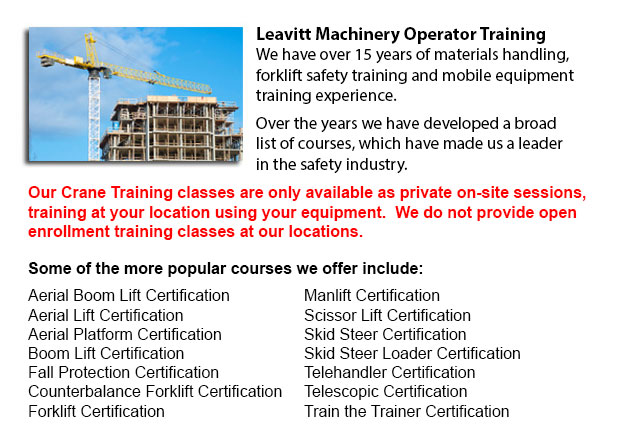
Kitchener Overhead Crane Safety Training - The overhead crane safety training program is designed to equip the operators with the right knowledge and skills in the areas of: crane safety precautions, materials handling, accident avoidance, and stock and equipment protection. Each of the trainees would get to learn on many types of overhead cranes, their capabilities and their uses in different environments. For operators who are trained and licensed, the shift in liability moves to the operator from the company. Thus, the program emphasizes individual operator duties.
The operators in the overhead safety training course will be given instruction about the correct techniques for doing checks: the pre-shift inspection and the more detailed in-depth inspection. These are vital every day routines that must be logged. Correctly recorded pre-shift inspections help to protect the business from liability in the event of an accident. Pre-shift inspections also prevent damage, expensive repairs and accidents. Operators learn how to designate a specific person to carry out inspections, how to report problems, and how to maintain the log book.
Each and every inspection should be carried out and documented regularly. Things that must be inspected for possible concerns, include: hooks for cracks, increases in the throat opening, hoist ropes for corrosion, degree of twist, worn wires, loss of diameter, broken wires, kinks and bird caging, chains for gouges and nicks, chemical and heat damage, cracks and corrosion, twists, excessive wear, distortion, pits, stretching, damage caused by extreme heat.
Operators learn correct rigging procedures in this program. Rigging involves understanding the manufacturer's data plate, determining the material weight to be lifted, selecting the gear, and utilizing safe practices to secure the load. The course cover in detail the following: safe working loads, and the capacities of ropes, chains, hooks, shackles and slings.
It is essential to know who could operate the cranes at your facility, physical requirements of the job, and operator qualifications required for specialized tasks and permits. Safety is a top priority when operating in the vicinity of pedestrian traffic.
The duties included in the safe crane utilization consists of undertaking visual inspections, checking for hydraulic leaks, testing the controls, checking the safety guards, examining the hook and hoist rope, limit switches and braking mechanisms. Right reporting procedures are important. These subject matters are all included in depth in the program.
Right lifting and moving procedures with cranes and hoists are included in the program. Operators would become skilled in hand signals. Training involves how to attach the load, raise the load, abort a lift, set the load and unhook the slings.
The steps involved with moving the load, includes: stopping and starting procedures, controlling and guiding the load, working with signals and observing working conditions. In case of power failures, the operator would have to know how to proceed. The program covers methods for lowering the load and removing the slings, storage of equipment, parking the crane, and securing an indoor and outdoor crane.
-
Kitchener Forklift Training Schools
Kitchener Forklift Training Schools - The Advantages Of Taking One Of Our Forklift Training Schools Are you searching for work as a driver of a forklift? Our regulatory-compliant mobile equipment operator training offers instruction in types of fo... More -
Kitchener Overhead Crane Operator Training
Kitchener Overhead Crane Operator Training - Our overhead crane operator training course is designed to teach employees the basics of overhead crane/sling operation and pre-shift checks. Courses are taught by our expert trainers and consultants. Well... More -
Kitchener Crane Training School
Kitchener Crane Training School - The crane training school offers industry-relevant programs. Courses provide trainees with learning outcomes which match present industry demands. Our small class sizes combine hands-on experience and theory. Our qua... More -
Kitchener Skid Steer Ticket
Kitchener Skid Steer Ticket - The lift arms on the skid-steer loader are located at the side of the driver along with pivots behind the driver's shoulders. These features makes the skid-steer loader different as opposed to the conventional front load... More -
Kitchener Manlift Operator Certification
Kitchener Manlift Operator Certification - Our scissor platform and aerial lift training and certification empowers participants with a knowledge and general understanding of the efficient and safe use of "Power Operated Mobile Work Platforms," under... More -
Kitchener Crane Safety Training
Kitchener Crane Safety Training - Companies and crane operators have to be aware of the problems related to crane safety. Legislation provides rules for the safe operation, inspection and maintenance of lifting machines all around North America. Cran... More -
Kitchener Forklift Training Programs
Kitchener Forklift Training Programs - Are you searching for work as a forklift driver? Our regulatory-compliant mobile equipment operator training offers instruction in kinds of forklifts, pre-shift check, fuel kinds and dealing with fuels, and safe... More -
Telehandler Training in Kitchener
Telescopic handlers often known as telehandlers for short, are an extremely popular piece of heavy construction machinery. They are commonly used in the construction and agricultural industries. These equipments have extreme reaching ability and can... More

Forklift Certification Kitchener
TOLL FREE: 1-888-254-6157
Kitchener, Ontario
forkliftcertificationkitchener.com
Email Us
About Us


